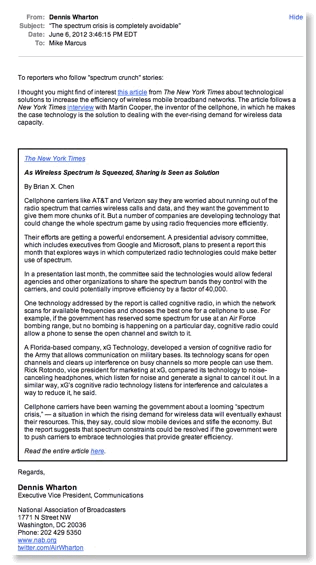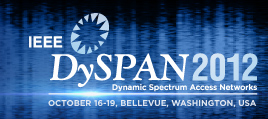Dynamic spectrum access
NAB: Cognitive Radio is Effective Enough to Allow Sharing of Critical Government Frequencies - But Not Good Enough to Protect Broadcast TV
The National Association of Broadcasters, along with the Association for Maximum Service Television , Inc. (MSTV) (with which it has now merged), vigorously fought in 186 different filings the cognitive radio proposals in Docket 04-186 to allow secondary use of TV whitespace. When all was said and done they only allowed cognitive radio sensing with a maximum transmitter power of 50 mW (47 CFR 15.717(b)) and even that provision has an unprecedented notice and comment provision that makes its implementation unlikely.
So you can see how surprised and excited I was to get the e-mail shown at left from Dennis Wharton, Executive Vice President of Communications at NAB, with the subject line “The spectrum crisis is completely avoidable”. We certainly want to avoid this crisis and I was delighted to read what NAB’s new solution was. The message begins with “I thought you might find of interest this article from The New York Times about technological solutions to increase the efficiency of wireless mobile broadband networks.” The Times article was mainly about the PCAST spectrum report that SpectrumTalk readers read about here on May 28th. In the article Mr. Wharton was kind enough to recommend was a discussion of how effective cognitive radio technology now is and the statement “For example, if the government has reserved some spectrum for use at an Air Force bombing range, but no bombing is happening on a particular day, cognitive radio could allow a phone to sense the open channel and switch to it.”
Mr. Wharton, let me explain why it is much easier for a cognitive radio to sense in TV white space whether there are usable TV signals than the case of sensing the presence of military signals:
Based on the above, cognitive radios in the TV band raise far fewer issues than cognitive radios that try to detect the presence of military signals.
Since Mr. Wharton has concluded that cognitive radio technology has now advanced to the point that it can reliably detect the presence of military signals to allow broadband use of military bands when and where they are not in use, I assume that NAB must now endorse the technically simpler case of using of cognitive radios in the TV bands under similar terms.
I hope Mr. Wharton comes to the DySPAN 2012 Conference in Bellevue WA in October and explains NAB’s new view on cognitive radio. I’m sure he’ll get a standing ovation!
So you can see how surprised and excited I was to get the e-mail shown at left from Dennis Wharton, Executive Vice President of Communications at NAB, with the subject line “The spectrum crisis is completely avoidable”. We certainly want to avoid this crisis and I was delighted to read what NAB’s new solution was. The message begins with “I thought you might find of interest this article from The New York Times about technological solutions to increase the efficiency of wireless mobile broadband networks.” The Times article was mainly about the PCAST spectrum report that SpectrumTalk readers read about here on May 28th. In the article Mr. Wharton was kind enough to recommend was a discussion of how effective cognitive radio technology now is and the statement “For example, if the government has reserved some spectrum for use at an Air Force bombing range, but no bombing is happening on a particular day, cognitive radio could allow a phone to sense the open channel and switch to it.”
Mr. Wharton, let me explain why it is much easier for a cognitive radio to sense in TV white space whether there are usable TV signals than the case of sensing the presence of military signals:
- TV signals are generally on 24/7, they do not turn on and off at random times as military signals do.
- TV transmitters are firmly bolted to the ground in well defined locations.
- TV signals have a very precisely defined (in a public documentation) 6 MHz wide waveform with very precise frequency stability and timing. It is almost as if they were designed to be detected at much greater sensitivity than a consumer receiver. Indeed, FCC testing showed that they could be detected at a power level 35 dB less than the sensitivity of a TV receiver and better detectors are possible. In general military signals do not have waveforms that are known to the public. Thus the U-NII cognitive radio rules in 47 CFR 15.407(h)(2) require a “Radar Detection Function of Dynamic Frequency Selection” that knows nothing about the radar signal it is trying to detect since the military would no divulge the specific technical details of the radars in the band - a far cry from the well known ATSC signal in the TV band!
- If interference is caused to TV reception, it may be unfortunate but there are no permanent negative consequences - like death or injury. If there is interference to a military system the consequences could me more severe.
Based on the above, cognitive radios in the TV band raise far fewer issues than cognitive radios that try to detect the presence of military signals.
Since Mr. Wharton has concluded that cognitive radio technology has now advanced to the point that it can reliably detect the presence of military signals to allow broadband use of military bands when and where they are not in use, I assume that NAB must now endorse the technically simpler case of using of cognitive radios in the TV bands under similar terms.
I hope Mr. Wharton comes to the DySPAN 2012 Conference in Bellevue WA in October and explains NAB’s new view on cognitive radio. I’m sure he’ll get a standing ovation!
Comments
Can Cognitive Radio Technology Help Solve Some Difficult Spectrum Management Issues by Creating "Virtual Guardbands"?

The hidden node problem refers to the problem of protecting receivers from interference in a cognitive radio system when you can’t explicitly detect the receiver’s presence. This is the crux of the TV whitespace problem since TV receivers can not announce their presence. (In that case the use of cognitive radio detectors 20+ dB more sensitive than TV receivers can be used to solve the problem although FCC chose the more conservative approach of geolocation for initial implementation.)
The instant article considers the case of a full duplex mobile transmitter with known frequency offset, as in the case of the ubiquitous cellphone. It points out that in this case the hidden node is no longer “hidden” since it can be readily detected at short distances by the uplink signal and that the receiver frequency can also be calculated by adding the offset to the detected uplink frequency.
This is a special case of Preston Marshall’s general observation that while cognitive radios are best known for finding empty spectrum that can be used without cochannel interference, if you know the location and characteristics of nearby receivers you can also select frequencies that will not result in interference from adjacent channel or intermodulation mechanisms in receivers with limited rejection capability. Pres points out that receiver ejection capability is generally expensive because it requires on precise analog components, whereas cognitive radio technology is mostly digital with little marginal cost in the long run.
In the AWS-3 proceeding, T-Mobile, the adjacent channel licensee in most places, claimed that adjacent channel interference to their FDD downlink was inevitable if the adjacent AWS-3 were used for either uplinks or TDD. Since we now know that T-Mobile was “on the auction block” during this deliberation, they had every incentive to maximize their sale value by using a massive legal effort for both trying to stop a new entrant and removing any risk of interference from concerns of potential purchasers. One of the parties in the AWS-3 proceeding mentioned a variant of virtual guardbands in comments, but this was promptly dismissed by the cellular mainstream as speculative.
But while there might be some slight question of how well TV whitespace devices can detect a TV signal from 50 miles away that provides marginal reception to TV sets using antennas near the devices, detecting a cellphone uplink signal nearby - the only place where adjacent channel or intermodulation interference is a threat - is trivial by comparison.
Industry loves to demand guardbands: it is a proven technology to prevent interference and also limits competition. But guardbands also have a real cost in our spectrum dependent economy that is always searching for more spectrum. Virtual guardbands can be a realistic way to use today’s technology to avoid interference while allowing more intense spectrum use at the boundaries of FDD bands.
FCC has never resolved the AWS-3 issue, they just told M2Z Networks that no answer was coming soon. AWS-3 continues to lie fallow as we beat the bushes to find the 500 MHz of new spectrum demanded by the National Broadband Plan. - there are no easy answers. Maybe with technologies such as virtual guardbands we can put AWS-3 to use serving society and the economy. With AT&T and T-Mobile now before the Commission begging for permission to merge, maybe they can more more flexible on the AWS-3 issue as a merger condition.





![Validate my RSS feed [Valid RSS]](valid-rss-rogers.png)

